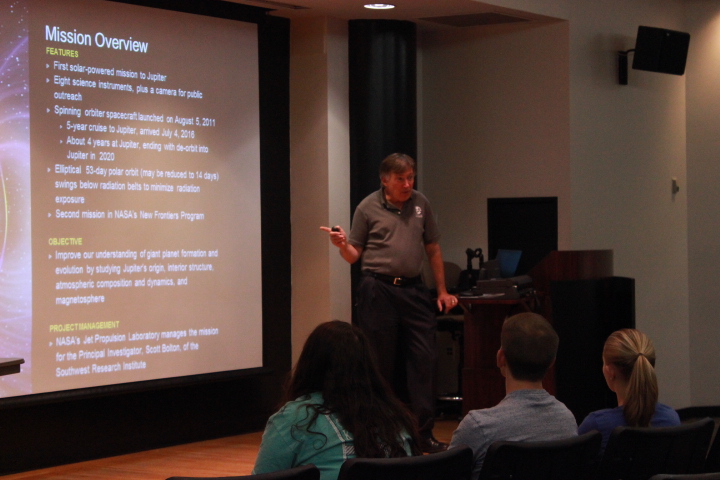A professor from the Georgia Institute of Technology gave a lecture on Nov. 17 about NASA’s Mission Juno that is currently in orbit around the planet Jupiter.
Professor Paul Steffes’ lecture — titled “Mission Juno: Unlocking Jupiter’s Secrets” — informed students of the latest findings of the spacecraft and what they can expect from NASA in the future.
Steffes has been involved with Mission Juno since its beginning in 2005. Of the nine instruments on the Juno spacecraft, Steffes is involved with the microwave radiometer, which measures the amount of water in Jupiter’s atmosphere.
“Water contains oxygen, and oxygen is one of the fundamental elements for life,” Steffes said.
The Juno Mission aims to answer several questions including how Jupiter formed, what the planet is made of, how far down its atmosphere goes and how the planet is arranged inside.
The Juno spacecraft launched on Aug. 5, 2011, and arrived at Jupiter July 4, 2016. The spacecraft will spend about four years orbiting Jupiter, the largest planet in the solar system, and end the trip in 2020.
Scientists will know if Jupiter has a core at the center of the planet in about a year and a half, Steffes said.
Juno is the second mission in NASA’s New Frontiers Program. The mission objectives include improving the understanding of giant planet formation and evolution by studying Jupiter’s origin, infrastructure, atmospheric composition and magnetosphere.
“Jupiter’s dynamical belts and zones don’t just go down a couple hundred or thousand feet — they go down a couple hundred miles,” Steffes said. “So this is a big insight that we got from our very first pass on Aug. 27.”
The spacecraft is also examining Jupiter’s north pole where storm-like features are found. Jupiter is so big and has so much energy due to its gravity which is why storms are found in unexpected regions on the planet, Steffes said.
“One of the first things we found with Juno is that Jupiter’s north pole is a very interesting place because it is so dynamic,” Steffes said.
He played a video of a simulation of Juno entering Jupiter’s orbit where students observed the planetary motion of Jupiter’s four main satellites — Io, Europa, Ganymede and Callisto — orbiting the planet.
Students listened to the sound of natural radiation through Jupiter’s radiation belt during the lecture. After 37 orbits, the Juno spacecraft will have received a dose of radiation equivalent to 100 million dental X-rays, Steffes said.
The radiation will eventually render the spacecraft uncontrollable and it will be de-orbited and crash into Jupiter.
NASA’s next trip will be the Europa Clipper Mission where an orbiter or micro-lander will fly around Jupiter and pass Europa several times to collect data on it.
“Europa is the big ball of ice with a lot of liquid water inside,” Steffes said. “So they really want to know what the conditions are inside.”
NASA has an online simulation, “Eyes on Juno,” in which the viewer rides along with the spacecraft during any time of the Juno mission. Updated pictures from Juno’s mission are available online along with more information on the mission’s history.



Seriously, you can’t even see the north pole of jupitor in these photos, its in shadow!, all thats visable is the edge of a massive hexagon! I would like suggest that the hexagon atop saturn (and jupitor) is more simple than we realise, magnetism has a centripetal vortex which pulls matter closer together, the tightest formation under pressure results in packing atoms into hexagonal close packing or geometric placements, around a single point, this create hexagons in the geology or atmosphere of the planets with a strong enough magnetic core. All planets have hexagons in their north poles geology as can be seen with the naked eye on all of nasas photos (just look for them). Find a facebook page called electric field lines to see what I mean. Ken wheelers book, ‘uncovering the secrets of magnetism’ explains all we need to figure out what’s going on in all of nature, cosmology and the attempts of particle physics. the mainstream is embarrassed and faulty in all of its conclusions. Look at the picture of the southern red aurora, it’s hexagonal! Are you blind? where’s the field theorists on this!!!?
Seriously, I’m going to need you to learn how to spell Jupiter before leaving a very difficult-to-read comment. Are YOU blind? Just because you have some hair on your chin in this photo doesn’t mean you are safe.